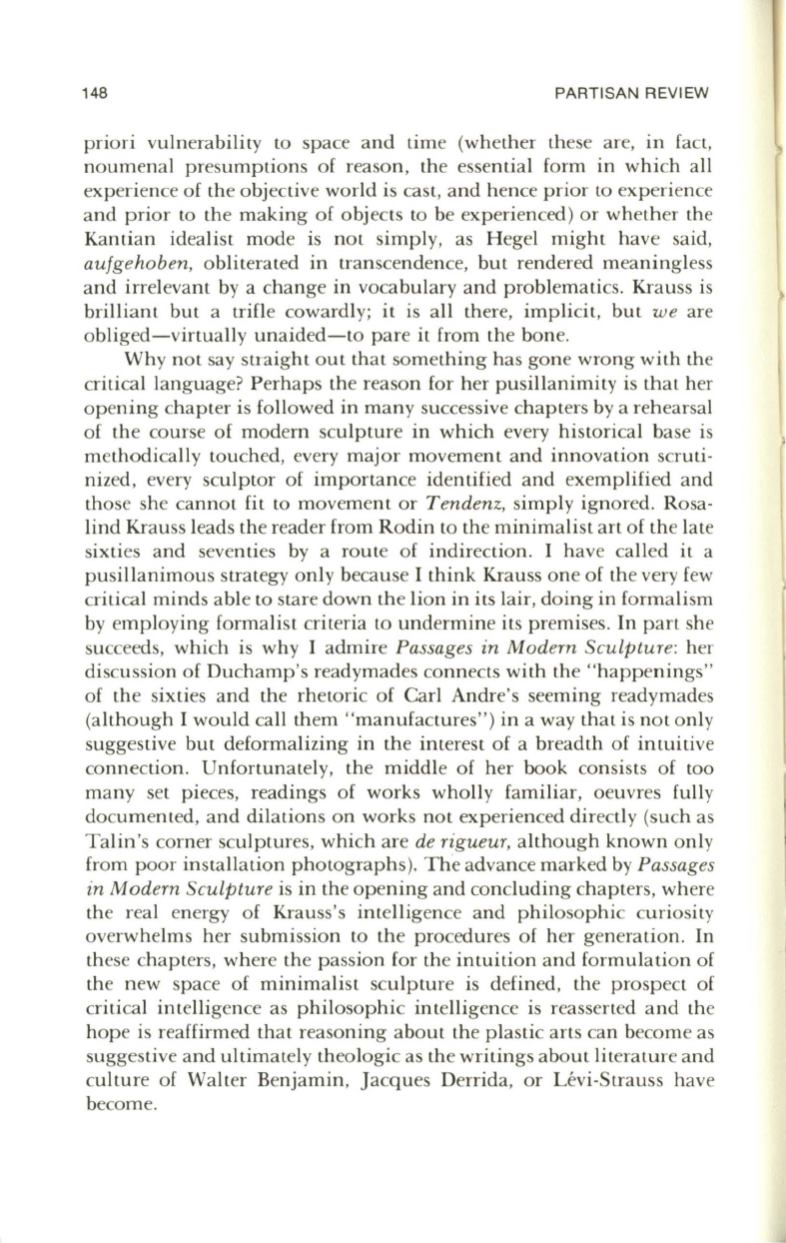
148
PARTISAN REVIEW
priori vulnerability to space and time (whether these are, in fact,
noumenal presumptions of reason, the essential form in which all
experience of the objective world is cast, and hence prior to experience
and prior to the making of objects to be experienced) or whether the
Kantian idealist mode is not simply, as Hegel might have said,
aufgehoben,
obliterated in transcendence, but rendered meaningless
and irrelevant by a change in vocabulary and problema tics. Krauss is
brilliant but a trifle cowardly; it is all there, implicit, but
we
are
obliged-virtually unaided-to pare it from the bone.
Why not say straight out that something has gone wrong with the
critical language? Perhaps the reason for her pusillanimity is that her
opening chapter is followed in many successive chapters by a rehearsal
of the course of modern sculpture in which every historical base is
methodically touched, every major movement and innovation scruti–
nized, every sculptor of importance identified and exemplified and
those she cannot fit to movement or
Tendenz,
simply ignored. Rosa–
lind Krauss leads the reader from Rodin to the minimalist art of the late
sixties and seventies by a route of indirection. I have called it a
pusillanimous strategy only because I think Krauss one of the very few
critical minds able to stare down the lion in its lair, doing in formalism
by employing formalist criteria to undermine its premises. In part she
succeeds, which is why I admire
Passages in Modern Sculpture:
her
discussion of Duchamp's readymades connects with the "happenings"
of the sixties and the rhetoric of Carl Andre's seeming readymades
(although I would call them "manufactures") in a way that is not only
suggestive but deformalizing in the interest of a breadth of intuitive
connection. Unfortunately, the middle of her book consists of too
many set pieces, readings of works wholly familiar, oeuvres fully
documented, and dilations on works not experienced directly (such as
Talin's corner sculptures, which are
de rigueur,
although known only
from poor installation photographs). The advance marked by
Passages
in Modern Sculpture
is in the opening and concluding chapters, where
the real energy of Krauss's intelligence and philosophic curiosity
overwhelms her submission to the procedures of her generation. In
these chapters, where the passion for the intuition and formulation of
the new space of minimalist sculpture is defined, the prospect of
critical intelligence as philosophic intelligence is reasserted and the
hope is reaffirmed that reasoning about the plastic arts can become as
suggestive and ultimately theologic as the writings about literature and
culture of Walter Benjamin, Jacques Derrida, or Levi-Strauss have
become.


